Multiple Vendors
This chapter presents companies which made products with Series 32000 or at least announced them. But no real hardware could be found yet.
National Semiconductor showed in an advertisment a list of companies using Series 32000 chips. From two of them no information is available: Zaiaz and Hightec EDV Systems. The last one was located in Saarbrücken in Germany.
Another source of information is a list of companies which have used the compilers of Green Hills Software Inc. for their systems. From the companies Calcomp and Daisy Systems I have no information of what they have sold. Green Hills made C, Fortran and Pasal compilers for Series 32000. I know them from Definicon. Unfortunately for me their Pascal compiler is not useable. I'm used to Turbo Pascal and they implemented a very basic idiom of Pascal.
Aeon Technologies
The Aeon:332/AT of Aeon Technologies was a coprocessor for the IBM AT which used the NS32332 CPU. The NS32382 MMU was also used. They sold it with 1 MByte of DRAM in OEM quantities for $1995.
There is a hint that they have built also a version with the NS32532 CPU: I saw the product name Aeon:532/AT in an internet conversation.
Avalon Computer Systems
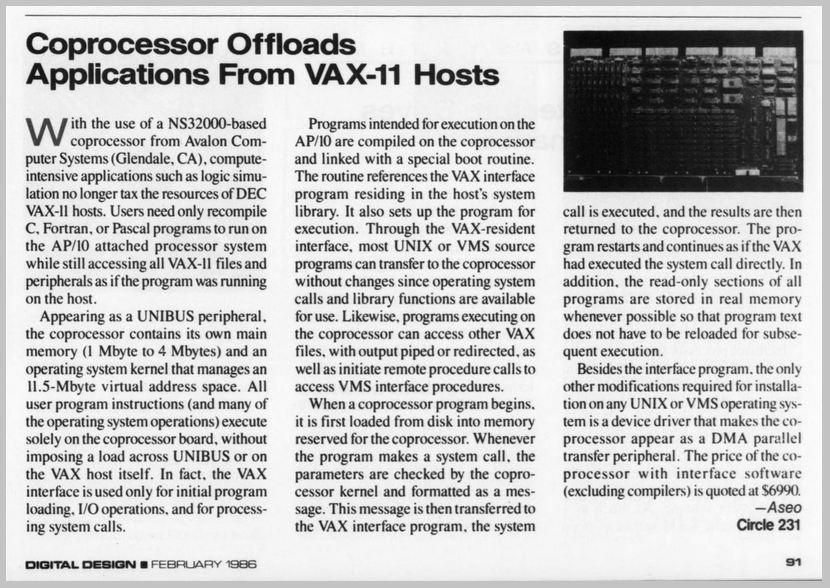
DFE Electronic Data Systems
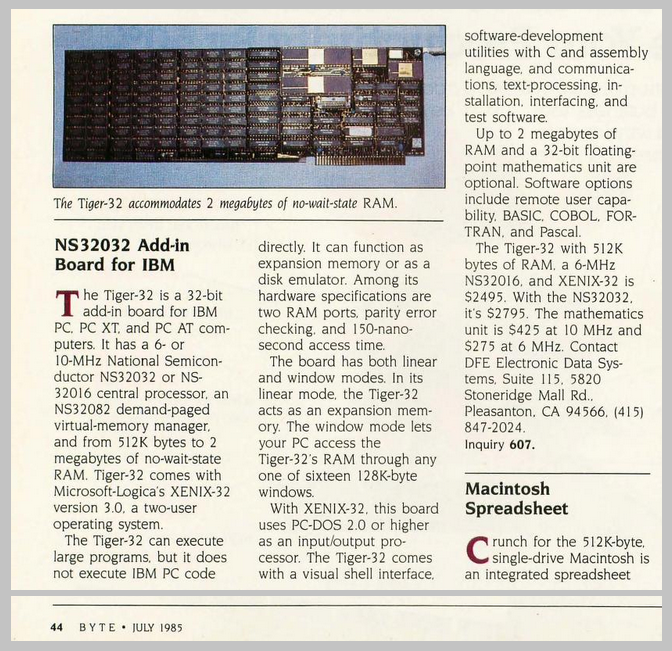
The Tiger-32 uses the NS32016 CPU. For the NS32032 CPU the company must have built another version.
E-LAB
E-LAB is a german company still existing in 2017. In 1985 they offered a board called "CPU 32/32" which they claimed to be the first european MultibusII board. The board was based on the NS32032 CPU. Main memory was expandable from 256 kbytes based on 64-kbit memory chips up to 4 Mbytes with 256-kbit memory chips in special sockets and an additional add-on board. The memory could be optionally protected against faults by ECC (Error Correction Code). One bit error could be corrected and two bit errors were detectable. This concept was not found very often in the 1980's. Most vendors prefered parity protection which requires not much hardware ressources.
E-LAB was the only company I know which talked about the NS32132 CPU. They said that the "CPU 32/32" board could be equipped with two NS32132's instead of one NS32032 and the socket for the second CPU is already on the board. Up to now it is still questionable whether this processor had ever existed.
E-LAB offered another board based on the NS32008 CPU. The form factor of the board was Euro card. A lot of boards were sold to the physics experiment DESY in Hamburg/Germany.
Today nothing is left from the times they were using Series 32000 processors. Which is no surprise...
Flexible Computer
Flexible Computer was located in the US. The company built a computer system based on the NS32032 CPU named Flex/32. It was a multiprocessor system which used a maximum of 20 boards. Each board could be a processor board or a memory board. The processor board had one NS32032 CPU and its own DRAM memory with a capacity of 1 to 4 Mbytes. The memory board had 8 Mbytes capacity and was shared between the CPU boards.
General Robotics
General Robotics presented in 1984 at the NCC their first Series 32000 based product, the Python/32 Single Board Mainframe using the NS32032 CPU. The price was approximately $60,000 in single quantities. The following systems were the Python/32B and a series of products for DEC's Q-bus including the Python/32T running a 12.5 MHz fast NS32032 (according to an anouncement in a newspaper but such a CPU never existed), the Python/JR for one to eight users and the Super Python for more than 100 users. I guess that the last one was based on the NS32332 CPU. The company was located in Hartford, Wisconsin/US.
Heurikon
Heurikon was a company in the US which built a NS32532 CPU based computer called the HK32/V532. It comprised a single double-height Eurocard, aimed at embedded control and low-cost systems applications. As well as being marketed separately, it was being sold in various standard and customized systems configurations with other members of Heurikon's VME range. Features of the HK32/V532 included the CPU running at up to 30MHz, 4-16 Mbytes of onboard dynamic RAM, up to 1 Mbyte of EPROM, optional floating-point coprocessor, four-channel DMA, interrupt control unit, SCSI interface and two RS232 ports, 128 bytes of static RAM for user functions and a clock. The available software was Unix system V release 3 and the realtime operating system VRTX.
A Great Wall Paper
In July 2024 Mark informed me that he owns an advertisement of Heurikon in the form of a wall paper. This was great news because I have never seen something from this company.
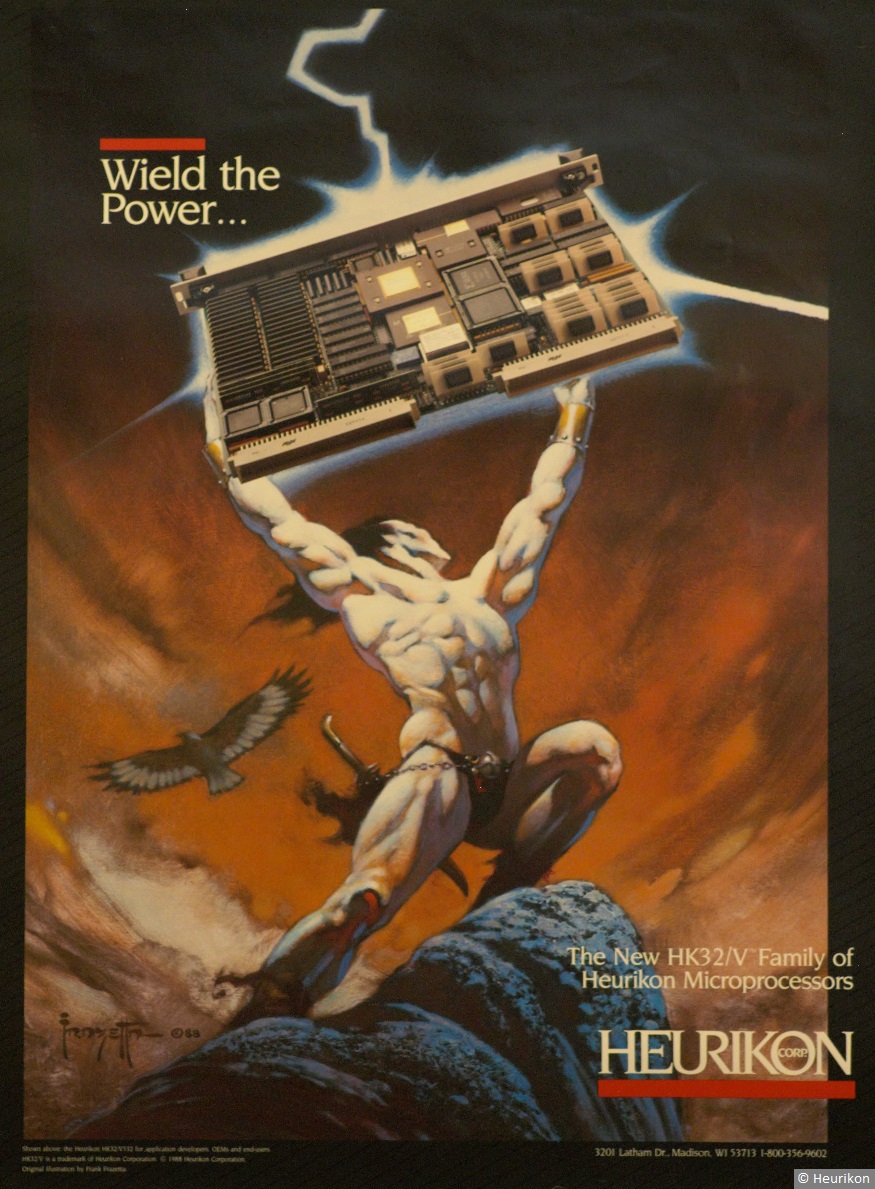
Fig. 1. The wall paper of Heurikon: there is someone very proud of his product to make such an advertisement.
The text in the lower left corner says:
Shown above the Heurikon HK32/V532 for application developers, OEMs and end users
HK32/V is a trademark of Heurikon Corporation © 1988 Heurikon Corporation
Original illustration by Frank Frazetta
Frank Frazetta was a famous painter of fantasy art. I'm sure that one of his pictures is being reused for this advertisment. But I did not find the origin yet.
The wall paper shows for the first time the HK32/V532 board. It looks very impressive. The main difference between VME532 from NSC and the Heurikon board is the memory: HK32/V532 has no cache, VME532 has no DRAM on board.
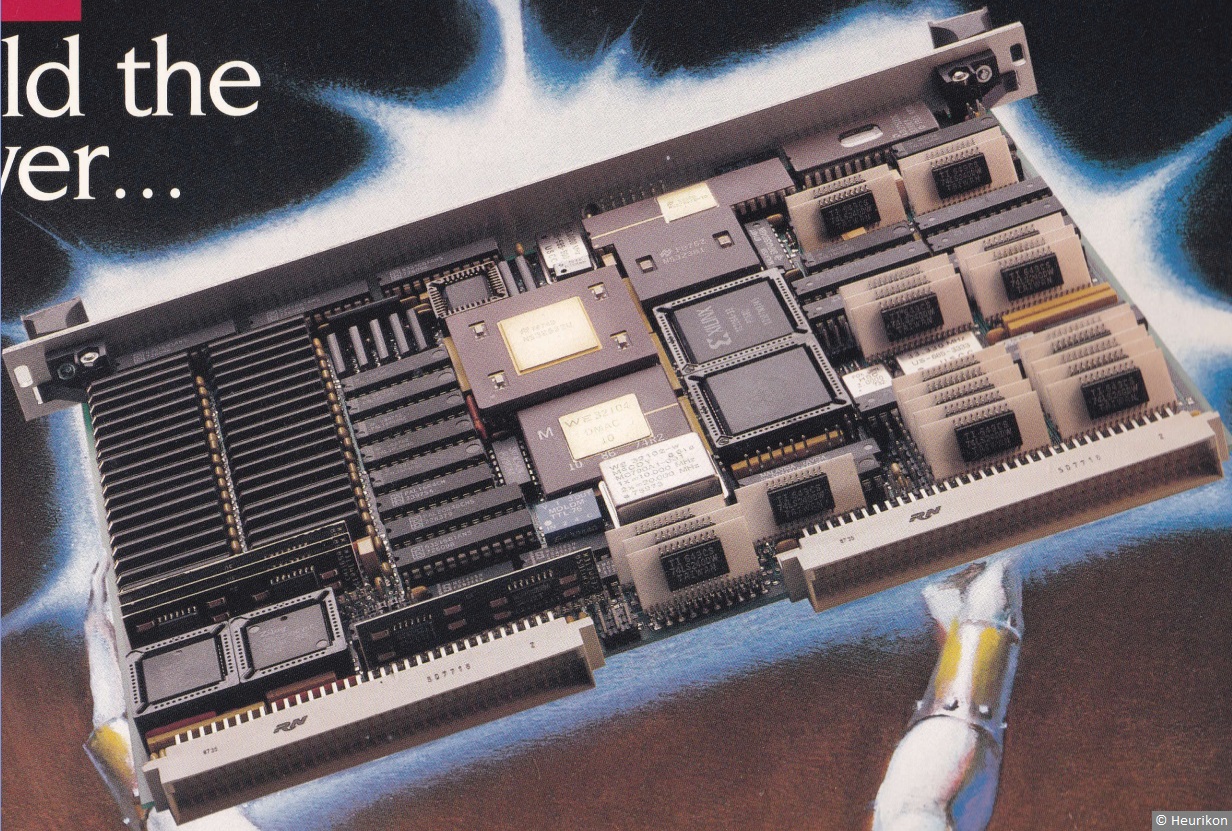
Fig. 2. The high qualtiy of the wall paper showed many details of the HK32/V532 board.
The board contains an FPGA from Xilinx. Another interesting device is the DMA controller WE32104. It is part of the microprocessor family WE32100 of Western Electric. Not only the numbering of Series 32000 and WE32100 is very similar also the architecture is similar.
As one can see the first 20-pin SMD devices were not so narrow. Obviously they saved not much board space. Therefore Heurikon used them vertically by placing them on small pcbs. It is a clever solution which I have not seen on other products.
Mark, thank's a lot for all your hard work to take a good photo of the wall paper and to save it for over 30 years!
Intergraph
Intergraph was a big vendor of engineering software in the 1980's. In addition the US based company made their own hardware to best support the software. In September 1984 they announced the workstation InterPro 32 which used the NS32032 CPU. InterPro 32 had a 15 inch color monitor with a resolution of 1184 by 884 pixel (strange format...). Main memory was 2 Mbytes upgradable to 4 Mbytes. The system software was Unix.
Due to the problems that National Semiconductor had with delivering working silicon of the NS32032 in 1984 the first systems used the NS32016. But this version of the InterPro 32 was slow compared to workstations from other vendors. The situation changed not much when the NS32032 became available and Intergraph stopped selling the workstation only one year after its introduction.
Logical MicroComputer
Logical MicroComputer (LMC) designed an NS32016 based computer for the Multibus. The price of the LMC MegaBoard with FPU and MMU was $4000. The system LMC MegaMicro was priced starting at $15,000. The company was located in Chicago.
One customer was the School of Music's Computer Music Project at the University of Illinois. In November 1984 a system with 1 MB of RAM, 42 MB hard disk and eight serial ports was installed. In addition they got a Selenar HiRez graphics terminal with a resolution of 1024*768 pixels, a Siemens PT-89 low noise printer, a 1200 baud modem and the sound system. The price of the complete system was $28,000. It runs Unix Version 7 which is 4.1 BSD. Surprisingly for me this department has used mainframes like IBM 4341 and Cyber 175 for sound synthesis in the 1970's.
Loral Instrumentation
Loral Instrumentation designed a multiprocessor system called LDF-100 based on the NS32016. The basic processing element (PE) contained two CPUs and a local memory of 128 up to 512 KBytes. The system architecture was described as a data-flow architecture. Astonishing was the range of PEs in a system: from 5 to 256 ! For a 5 MIPS (5 PEs) machine the price was $67,000. The biggest configuration with 256 PEs had a price of $1,900,000. I'm sure that nobody ordered such a system. The Computer History Museum has a manual with the title "Loral DATAFLO LDF-100 mini-supercomputer - System overview" in its store. A look into the manual from 1984 is on my to-do list...
Osiris Technology
Osiris Technology was another company with a system based on the NS32032. In the post on the usenet from 1986, Osiris wrote about the product:
"Osiris Technology has released an NS32032 based six to sixteen user supermicro, the Osiris One. The Osiris One is Australian designed and manufactured and is supplied with UNIX System V.2.2. A technical specification of the unit is given below. Current pricing is $15,000 Australian, ex tax. This price includes the basic unit, described below, plus a 16 user reconfigurable UNIX licence. ..."
To read the full text please go to https://groups.google.com/g/mod.newprod/c/_RNvEtsieWE .
Thanks to Steven for the finding of this post.
Sritek
The company Sritek built coprocessor boards for PCs like many other did. The photo in Figure 3 is taken from the website ummr.org. Unfortunately the author of the website is not available for any further information.
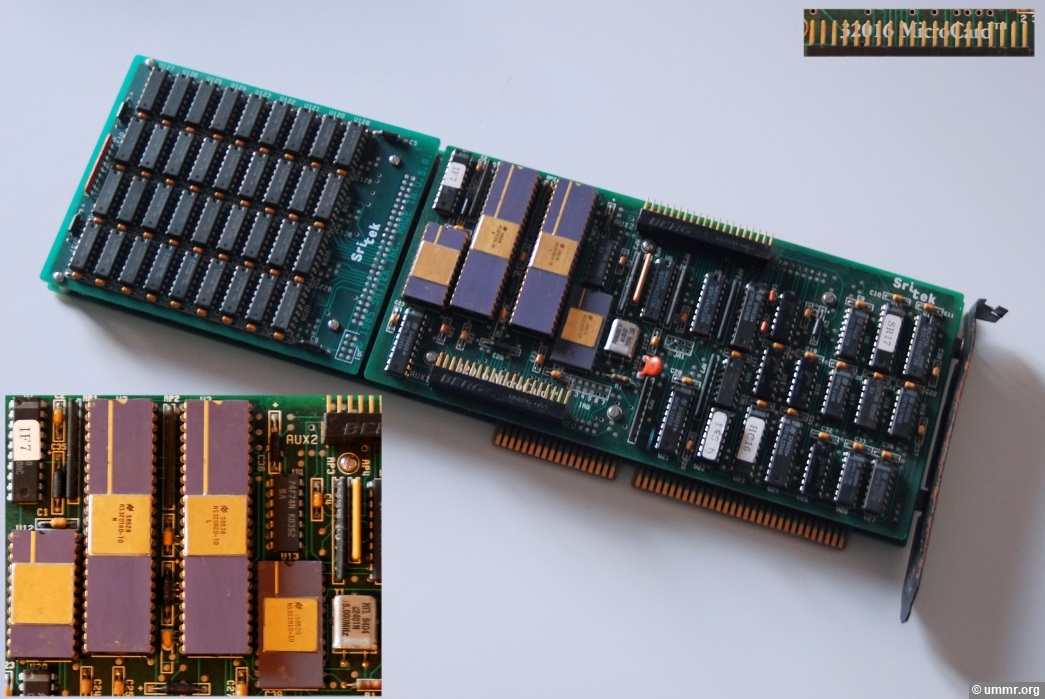
Fig. 3. The Sritek design contains three different boards: a CPU board, a memory board and a carrier board with the edge connector for the PC connection.
Stromberg-Carlson
The US-based company Stromberg-Carlson built telecommunication equipment for a long time. Its history can be found at Wikipedia.
The photo in Figure 4 shows a board which looks like the central processing unit of a telephone exchange. It is again taken from the website ummr.org. I tried to contact the maintainer of the website. But I was not successful.
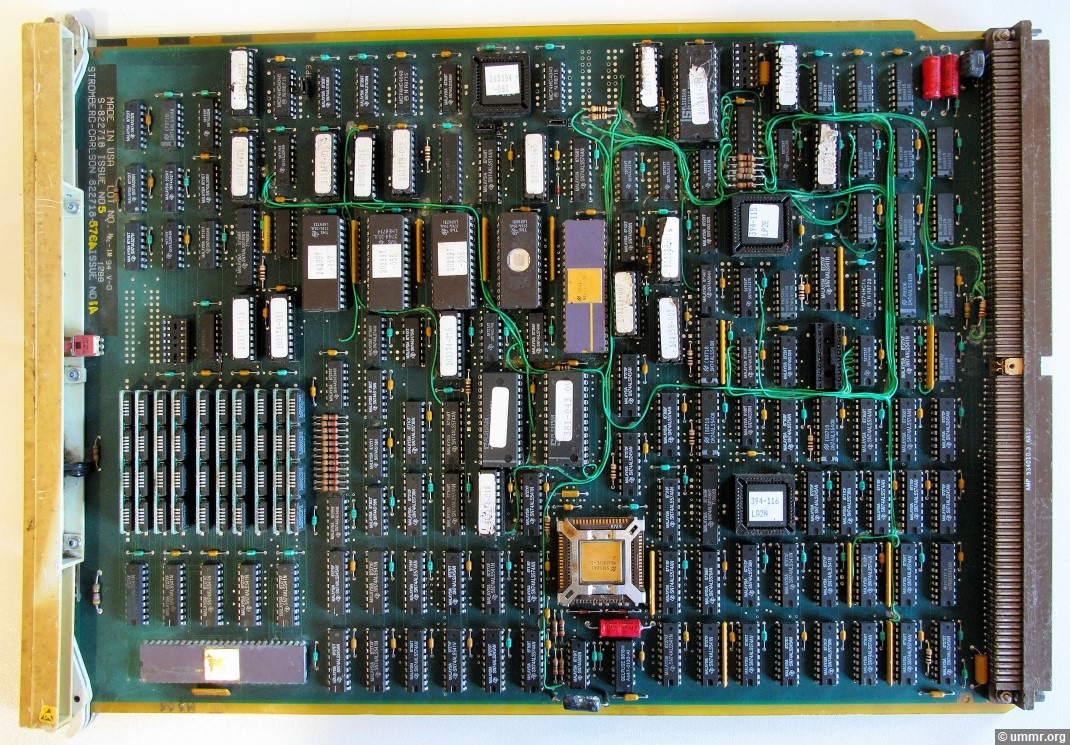
Fig. 4. The impressive board contains the NS32032 CPU, but not the TCU NS32201. How did they implement their functionality?
The 52 pin device in the lower left corner may be the SN74AS632 EDAC. This chip is used for error detection and correction in 32-bit systems. The ten small modules above are for sure memory modules. If they deliver 40 bits in parallel this is enough for 32 data bits and 7 check bits for single-error-correction and double-error-detection.
TRICON
TRICON builds fault tolerant computer systems. According to a presentation of June 1997 over 2500 TMR (Triplicated Modular Redundant) systems are installed worldwide. On page 24 the main processor architecture is shown. An NS32GX32 CPU together with the NS32381 FPU is used. It would be interesting to see such a system. The presentation can be downloaded here.
This chapter was last modified on 29 June 2025. Next chapter: National Semiconductor